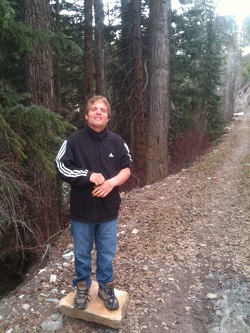By Sallie Bernard, President, SafeMinds

New research has just come out which will hopefully drive a stake into a scientific theory that has strangled scientific progress in autism. The theory – that autism’s cause is almost entirely genetic – hasn’t matched the evidence for decades and has undermined promising avenues to prevention and effective treatments.
My son with autism is a happy young adult with a big engaging personality. But his left hand is permanently swollen and scarred. He bites his hand when he gets anxious,occasionally so hard that it bleeds. Sometimes we know what triggers the panic attacks. Often we have no idea. They simply arise within, from his biology. In very anxious episodes he may pound his head and cry, “my head hurts.” His gift of autism comes with a heavy price.
Bill was diagnosed with autism in 1992 when he was four and a half years old. After developing normally for 2 1/2 years, he regressed into a severe condition marked by loss of speech and motor skills, behavior dysregulation and altered sensory and mood states that finally became what is called autism.
A few years after his diagnosis, the scientific theory that autism was all genetic—inherited from family members due to rare gene mutations—emerged as a way to explain the mystery of autism. At the time, this view was a step forward from the previous theory of autism as an outcome of bad parenting. At least it attempted to view autism as biologically based rather than psychosocial, and many parent advocates became believers.
The theory also fit the growing love affair among the larger scientific community with everything genetic as the way to solve mankind’s medical problems. And so the autism-as-genetic construct was quickly adopted and has remained entrenched dogma, with significant portions of autism research dollars flowing to labs which would find “autism genes.”
Unfortunately, the theory was based on a handful of small studies of twins, some with conflicting findings. By the late 1990s, the theory also was no longer matching the observable evidence.
A purely genetic etiology requires that autism has always been with us at the same rate for millennia, because genes evolve slowly. By the time my son enrolled in elementary school, I could see that the number of students in the younger grades was vastly larger than the older age groups. I could initially write this off as some missed diagnoses in the older kids, but then the ranks of the younger kids just kept swelling. Other parents and school teachers across the United States began noticing too. And like me, many of us whose children were diagnosed with autism had no history of autism in our families.
In the early 1980s, it was reported that 1 in 2500 children had autism.
In 2014, it is reported that 1 in 68 children have autism.
Yet our observations were dismissed as nonsense by mainstream scientists. We were told that the numbers of children with autism were not really increasing. We were told that there was no epidemic. Official recognition of an increase would put a brake on the genetics steamroller and all the dollars that come with it.
Now a new study of over two million children born in Sweden between 1986 and 2006, which has been published in the Journal of the American Medical Association, confirms what SafeMinds and parents have been saying for decades: children are as much at risk of getting autism from environmental factors as they are from their genetics. This study by Sven Sandin and his colleagues follows on the heels of another landmark study of twins by Joachim Hallmayer of Stanford, published in 2011, which showed that the larger component of autism risk arises from environmental not hereditary factors. (You can read Mark Blaxill’s informative and detailed discussion of the 2011 California Autism Twin study here.)
Since genes and environment interact to increase autism risk, this means that we are doing something to our children—exposing them to something harmful either while they are still in utero or during their first months or years of life—that is altering their biology. The scientific evidence is overwhelming. Researchers and science policymakers can no longer deny that there is a clear and strong environmental component to the skyrocketing rates of autism.
By ignoring the environmental component to autism, the government and scientific community have made a massive strategic error, wasting enormous amounts of money and time in mostly fruitless genetics-only research that has not helped us stop new cases of autism or helped people living with severe autism.
We can fix this. The studies by Sven Sandin and Joachim Hallmayer can guide us to the end of the autism epidemic. The good news is that environmental causes of neurological disorders are more easily fixed than genetics. When we invest in uncovering the environmental factors that are causing autism spectrum disorders, we can remove those factors from our world. We can study how those factors alter biology and identify the treatments that can remediate those pathways.
Based on this latest evidence, funders like NIH should be charging scientists with the urgent task of discovering what the environmental causes of autism are. Clinging to outdated paradigms harms our community. To its credit, the NIH’s National Institute of Environmental Health Sciences just released a request for proposals on Environmental Contributors to Autism Spectrum Disorders. To its discredit, the NIH’s Interagency Autism Coordinating Committee under the leadership of Dr. Tom Insel continues to obstruct environmental initiatives contained in its own Strategic Plan for Autism Spectrum Research.
My son was kicked out of nursery school. As he regressed into autism, his speech became so slurred we could no longer understand what he said. For over 20 years we have prioritized achieving a full life with autism. He does volunteer work at a local microbrewery where his co-workers enjoy his lively company. With his job coaches, he arranges the table settings and the outside patio. Though he still has acute anxiety and compulsions like rearranging the couch cushions, he is now able to work 70 minutes at a time.
The relentless disabling conditions that accompany autism can derail even the most valiant efforts to achieve a stable and fulfilling life. According to the new science, something environmental is pushing human biology off track. The implications are significant: We can find out what it is and stop it, and thus we are ethically required to do so. The struggles endured by my son and those like him may no longer be considered morally acceptable.
 Sallie Bernard is the president and co-founder of SafeMinds. She is a board member of Autism Speaks and president of Extreme Sports Camp, which offers outdoor adventures and full life experiences for youth and adults across the autism spectrum in Colorado.
Sallie Bernard is the president and co-founder of SafeMinds. She is a board member of Autism Speaks and president of Extreme Sports Camp, which offers outdoor adventures and full life experiences for youth and adults across the autism spectrum in Colorado.


